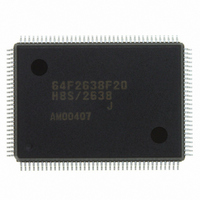HD64F2638F20J Renesas Electronics America, HD64F2638F20J Datasheet - Page 127

HD64F2638F20J
Manufacturer Part Number
HD64F2638F20J
Description
IC H8S MCU FLASH 256K 128-QFP
Manufacturer
Renesas Electronics America
Series
H8® H8S/2600r
Specifications of HD64F2638F20J
Core Processor
H8S/2600
Core Size
16-Bit
Speed
20MHz
Connectivity
CAN, SCI, SmartCard
Peripherals
Motor Control PWM, POR, PWM, WDT
Number Of I /o
72
Program Memory Size
256KB (256K x 8)
Program Memory Type
FLASH
Ram Size
16K x 8
Voltage - Supply (vcc/vdd)
4.5 V ~ 5.5 V
Data Converters
A/D 12x10b; D/A 2x8b
Oscillator Type
Internal
Operating Temperature
-40°C ~ 85°C
Package / Case
128-QFP
Lead Free Status / RoHS Status
Contains lead / RoHS non-compliant
Eeprom Size
-
Available stocks
Company
Part Number
Manufacturer
Quantity
Price
Company:
Part Number:
HD64F2638F20J
Manufacturer:
PENESAS
Quantity:
252
- Current page: 127 of 1512
- Download datasheet (9Mb)
H8S/2639, H8S/2638, H8S/2636,
H8S/2630, H8S/2635 Group
2.10
2.10.1
Only register ER0, ER1, ER4, or ER5 should be used when using the TAS instruction. The TAS
instruction is not generated by the Renesas Electronics H8S Family and H8/300 Series C/C++
compilers. If the TAS instruction is used as a user-defined intrinsic function, ensure that only
register ER0, ER1, ER4, or ER5 is used.
2.10.2
With STM and LDM instructions, register ER7 cannot be used as a register that can be saved
(STM) or restored (LDM) since it is the stack pointer.
The number of registers that can be saved (STM) or restored (LDM) by a single instruction is two,
three, or four. The registers that can be used in these cases are as follows.
Two registers: ER0–ER1, ER2–ER3, ER4–ER5
Three registers: ER0–ER2, ER4–ER6
Four registers: ER0–ER3
The Renesas Electronics H8S Family and H8/300 Series C/C++ compilers do not generate
STM/LDM instructions that include ER7.
2.10.3
The BSET, BCLR, BNOT, BST, and BIST instructions read data in a unit of byte, then, after bit
manipulation, they write data in a unit of byte. Therefore, caution must be exercised when
executing any of these instructions for registers and ports that include write-only bits.
The BCLR instruction can be used to clear the flag of an internal I/O register to 0. In that case, if it
is clearly known that the pertinent flag is set to 1 in an interrupt processing routine or other
processing, there is no need to read the flag in advance.
REJ09B0103-0800 Rev. 8.00
May 28, 2010
Usage Note
TAS Instruction
STM/LDM Instructions
Caution to Observe when Using Bit Manipulation Instructions
Page 77 of 1458
Section 2 CPU
Related parts for HD64F2638F20J
Image
Part Number
Description
Manufacturer
Datasheet
Request
R

Part Number:
Description:
KIT STARTER FOR M16C/29
Manufacturer:
Renesas Electronics America
Datasheet:

Part Number:
Description:
KIT STARTER FOR R8C/2D
Manufacturer:
Renesas Electronics America
Datasheet:

Part Number:
Description:
R0K33062P STARTER KIT
Manufacturer:
Renesas Electronics America
Datasheet:

Part Number:
Description:
KIT STARTER FOR R8C/23 E8A
Manufacturer:
Renesas Electronics America
Datasheet:

Part Number:
Description:
KIT STARTER FOR R8C/25
Manufacturer:
Renesas Electronics America
Datasheet:

Part Number:
Description:
KIT STARTER H8S2456 SHARPE DSPLY
Manufacturer:
Renesas Electronics America
Datasheet:

Part Number:
Description:
KIT STARTER FOR R8C38C
Manufacturer:
Renesas Electronics America
Datasheet:

Part Number:
Description:
KIT STARTER FOR R8C35C
Manufacturer:
Renesas Electronics America
Datasheet:

Part Number:
Description:
KIT STARTER FOR R8CL3AC+LCD APPS
Manufacturer:
Renesas Electronics America
Datasheet:

Part Number:
Description:
KIT STARTER FOR RX610
Manufacturer:
Renesas Electronics America
Datasheet:

Part Number:
Description:
KIT STARTER FOR R32C/118
Manufacturer:
Renesas Electronics America
Datasheet:

Part Number:
Description:
KIT DEV RSK-R8C/26-29
Manufacturer:
Renesas Electronics America
Datasheet:

Part Number:
Description:
KIT STARTER FOR SH7124
Manufacturer:
Renesas Electronics America
Datasheet:

Part Number:
Description:
KIT STARTER FOR H8SX/1622
Manufacturer:
Renesas Electronics America
Datasheet:












